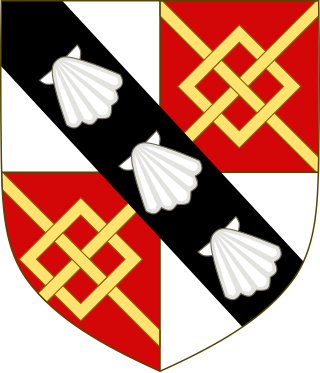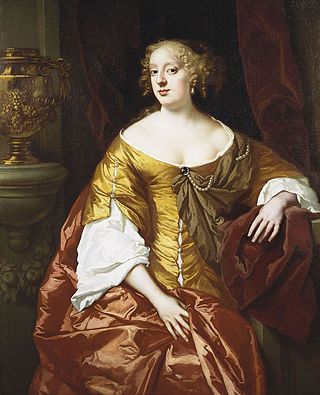
Duke of Marlborough is a title in the Peerage of England. It was created by Queen Anne in 1702 for John Churchill, 1st Earl of Marlborough (1650–1722), the noted military leader. In historical texts, unqualified use of the title typically refers to the 1st Duke. The name of the dukedom refers to Marlborough in Wiltshire.

Sarah Churchill, Duchess of Marlborough, Princess of Mindelheim, Countess of Nellenburg, was an English courtier who rose to be one of the most influential women of her time through her close relationship with Anne, Queen of Great Britain. The Duchess of Marlborough's relationship and influence with Anne were widely known, and leading public figures often turned their attentions to her, hoping for favour from Anne.

The Spencer family is an aristocratic British family. From the 16th century, its members have held numerous titles, including the dukedom of Marlborough, the earldoms of Sunderland and Spencer, and the Churchill barony. Two prominent members of the family during the 20th century were Sir Winston Churchill and Diana, Princess of Wales.

Mary Osborne, Duchess of Leeds, born Lady Mary Godolphin, was a daughter of Henrietta Godolphin, née Churchill, 2nd Duchess of Marlborough, and Francis Godolphin, 2nd Earl of Godolphin, making her granddaughter to the powerful government trio during the reign of Queen Anne of Great Britain: the famous general and politician John Churchill, 1st Duke of Marlborough, and his wife Sarah, Duchess of Marlborough, through her mother; and Sidney Godolphin, 1st Earl of Godolphin, through her father.

Charles Spencer, 3rd Earl of Sunderland, KG, PC, known as Lord Spencer from 1688 to 1702, was an English statesman and nobleman from the Spencer family. He served as Lord Lieutenant of Ireland (1714–1717), Lord Privy Seal (1715–1716), Lord President of the Council (1718–1719) and First Lord of the Treasury (1718–1721).

John Albert Edward William Spencer-Churchill, 10th Duke of Marlborough,, styled Marquess of Blandford until 1934, was a British military officer and peer.

Anne Emily Innes-Ker, Duchess of Roxburghe was the daughter of the 7th Duke of Marlborough, who served in Conservative governments as Lord President of the Council and Lord Lieutenant of Ireland. She served as Mistress of the Robes to Queen Victoria.

Charles Spencer, 3rd Duke of Marlborough,, styled as The Honourable Charles Spencer between 1706 and 1729 and as the Earl of Sunderland between 1729 and 1733, was a British Army officer, politician and peer who served as Lord Privy Seal in 1755. He led the British forces involved in the raid on St Malo in 1758.

Wriothesley Russell, 3rd Duke of Bedford was an English nobleman and peer. He was the son of Wriothesley Russell, 2nd Duke of Bedford. He was marginally involved in the politics of Hanoverian Succession.

George Charles Spencer-Churchill, 8th Duke of Marlborough, DL, styled Earl of Sunderland until 1857 and Marquess of Blandford between 1857 and 1883, was a British peer.

Anne Spencer, Countess of Sunderland was the wife of Robert Spencer, 2nd Earl of Sunderland and the daughter of George Digby, 2nd Earl of Bristol and Lady Anne Russell.

John Spencer was an English politician who sat in the House of Commons from 1732 to 1746.

Anne Churchill, later Anne Spencer, Countess of Sunderland, was an English court official and noble. She once held the office of Lady of the Bedchamber to Queen Anne.

Louisa Jane Hamilton, Duchess of Abercorn was a member of the British aristocracy. She and her husband, James Hamilton, 1st Duke of Abercorn, had 13 children, and were "long remembered as the most handsome and most distinguished young couple of their generation."
Frances Laura Spencer-Churchill, Duchess of Marlborough, was a British noblewoman and socialite. She was variously Viscountess Long, Countess of Dudley and became Duchess of Marlborough upon her fourth marriage, to John Spencer-Churchill, 10th Duke of Marlborough. She was the sister of novelist Hugo Charteris and Ann Charteris, as well as the granddaughter of Hugo Charteris, 11th Earl of Wemyss. Her third husband, Michael Temple Canfield, was the former husband of Lee Radziwill, sister of First Lady Jacqueline Bouvier Kennedy Onassis. During World War II, she served as an auxiliary nurse.

Caroline Spencer, Duchess of Marlborough, formerly Lady Caroline Russell, was the wife of George Spencer, 4th Duke of Marlborough.

Elizabeth Spencer, Duchess of Marlborough was the wife of Charles Spencer, 3rd Duke of Marlborough.

Gertrude Russell, Duchess of Bedford, formerly the Hon. Gertrude Leveson-Gower, was the second wife of John Russell, 4th Duke of Bedford. She was the eldest daughter of John Leveson-Gower, 1st Earl Gower, and his wife, the former Lady Evelyn Pierrepont. She married the Duke of Bedford on 2 April 1737.

Anne Russell, Duchess of Bedford, formerly Lady Anne Egerton, was the wife of Wriothesley Russell, 3rd Duke of Bedford, and, following his death, of William Villiers, 3rd Earl of Jersey. She was the mother of the 4th Earl of Jersey.

Elizabeth Churchill, later Elizabeth Egerton, Countess of Bridgewater, was the daughter of John Churchill, 1st Duke of Marlborough, and Sarah Jenyns. By marriage to Scroop Egerton, 1st Duke of Bridgewater, then 4th Count of Bridgewater, she was the Countess of Bridgewater.























